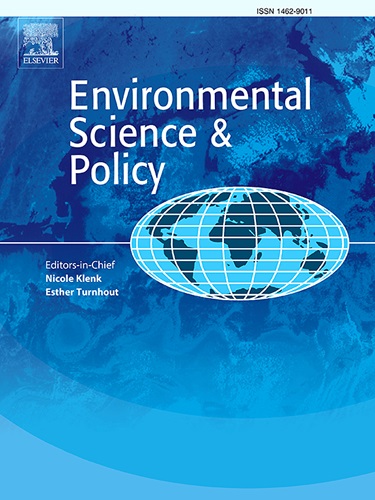解决水-能源-粮食-森林一体化关系治理中的差距
IF 5.2
2区 环境科学与生态学
Q1 ENVIRONMENTAL SCIENCES
引用次数: 0
摘要
森林在维持社区的水、能源和粮食系统方面发挥着关键作用。虽然世界经济论坛-森林系统之间的生态相互联系相对明显,但这些综合系统的管理通常是划分的,并以特定部门的规则和政策为中心。在本文中,我们采用了一个改进的机构间差距(IIG)框架来识别和描述可能存在于世界经济论坛不同级别管理机构的治理差距。我们将该框架应用于加拿大萨斯喀彻温省阿尔伯特王子模型森林(PAMF)的案例研究,以展示最小化治理差距的战略如何为世界经济论坛各部门带来积极成果。PAMF是加拿大首批示范森林之一。森林领域的主要社会经济活动包括采矿、森林工业和土著利用森林资源进行文化服务和生计活动。这片森林在土地使用方式、水污染以及野生动物和野生食物丧失方面存在冲突。我们采用访谈、参与观察、系统文献分析等多种方法收集数据。我们的分析表明,PAMF扮演了捐助者、促进者、经纪人、倡导者和企业家的角色,发展了一种基于伙伴关系的原始制度实践,有助于超越部门、数量和文化界限,实现世界经济论坛管理的国家和非国家机构的整合。这些实践有助于调动有效的世界经济论坛联系治理系统所需的知识和资源。本文章由计算机程序翻译,如有差异,请以英文原文为准。
Addressing gaps in integrative water-energy-food-forest (WEFF) nexus governance
Forests play a critical role in sustaining water, energy, and food (WEF) systems of communities. While the ecological interlinkages between WEF-forest (WEFF) systems are relatively evident, the management of these integrated systems is typically compartmentalized and centered around sector-specific rules and policies. In this paper, we employ a modified Inter-Institutional Gaps (IIG) framework to identify and characterize the governance gaps that may exist at different levels of WEFF governing institutions. We apply the framework to a case study of the Prince Albert Model Forest (PAMF), Saskatchewan, Canada to demonstrate how strategies that minimize governance gaps can bring about positive outcomes for WEFF sectors. The PAMF was one of the first Model Forests in Canada. Major socio-economic activities in the forest area involve mining, forest industries and the Indigenous uses of forest resources for cultural services and livelihood activities. The forest has a history of conflicting land use practices, water pollution and loss of wildlife and wild food. We collected data using multiple methods including interviews, participant observation, and systematic document analysis. Our analysis suggests that the PAMF has performed benefactor, facilitator, broker, advocate, and entrepreneurial roles to develop a partnership-based proto-institutional practice that helps to go beyond sectoral, scalar, and cultural boundaries for the integration of WEFF governing state and non-state institutions. These practices help mobilize knowledge and resources required for an effective WEFF nexus governance system.
求助全文
通过发布文献求助,成功后即可免费获取论文全文。
去求助
来源期刊

Environmental Science & Policy
环境科学-环境科学
CiteScore
10.90
自引率
8.30%
发文量
332
审稿时长
68 days
期刊介绍:
Environmental Science & Policy promotes communication among government, business and industry, academia, and non-governmental organisations who are instrumental in the solution of environmental problems. It also seeks to advance interdisciplinary research of policy relevance on environmental issues such as climate change, biodiversity, environmental pollution and wastes, renewable and non-renewable natural resources, sustainability, and the interactions among these issues. The journal emphasises the linkages between these environmental issues and social and economic issues such as production, transport, consumption, growth, demographic changes, well-being, and health. However, the subject coverage will not be restricted to these issues and the introduction of new dimensions will be encouraged.
 求助内容:
求助内容: 应助结果提醒方式:
应助结果提醒方式:


